Prioritizing is critical to the success of any business or endeavor. There are always competing problems, and you need to pick the right one to solve at any point in time.
Shooting for the moon is an enormous endeavor. But, while you shoot for the moon, you must ensure that you’ll last long enough to see that day when you get to the moon. So, the success of an optimized business rests heavily on identifying the right priorities and prioritizing goals according to what makes the most sense for your organization.
If I were given one hour to save the planet, I would spend 59 minutes defining the problem and one minute resolving it.
Albert Einstein once said, “If I were given one hour to save the planet, I would spend 59 minutes defining the problem and one minute resolving it.” This approach is critical as understanding the problem and its causality is the first step to solving it.
In the journey to solving your business problem, objectives define the future state (after the problem is solved), and key results measure the progress or outcomes you need to see along the journey. Setting goals and prioritizing OKRs correctly is an important part of having a successful OKR program.
Prioritizing Goals: Objectives
As a first step towards having the right list of OKRs, you must prioritize your objectives first and then the key results within each objective.
There are five buckets your objectives can fall into in the prioritization process:
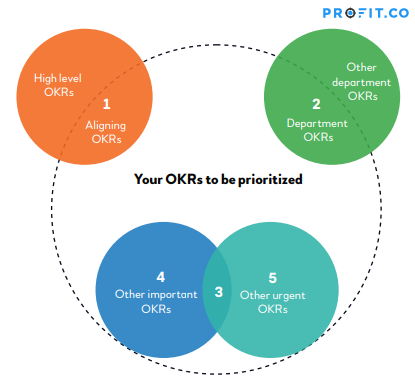
- Aligning OKRs
- Dependent OKRs.
- Important and Urgent OKRs.
- Important, but not Urgent OKRs.
- Urgent, but not important OKRs.
#1 – Aligning OKRs
First and foremost, you should prioritize objectives by aligning them within your organization– especially between your corporate and department-level OKRs. You have to trust your direct reports, right? If you have misalignment concerns, you have to make a point to resolve any confusion or lack of alignment before you launch into the quarter.
The same applies if you are an employee with individual OKRs, and you notice that your OKRs are out of alignment with departmental OKRs. You will have to have an open discussion with your direct supervisors. Aligned or cascaded OKRs are naturally top priority OKRs because they contribute towards other, larger goals in the company that must be completed.
#2 – Dependent OKRs
Once the “aligning objectives” are taken care of, next, you look at the non-aligning ones. While there are a few ways you can prioritize these OKRs, keep in mind that everyone is ultimately working towards fulfilling company objectives. With that end goal in mind, you should be helping other departments achieve OKRs that need your contribution in order to fulfill higher-level targets.
So, once your aligned OKRs are fulfilled, move on to your OKRs that other stakeholders in your organization are depending on in order to find success. Although we have shown in the diagram above shows that circles #1 and #2 do not necessarily overlap, they certainly can, as you might have dependencies with OKRs that align upwards.
#3 – Important & Urgent OKRs
Once aligned OKRs and dependent OKRs are taken care of, next, you focus on independent OKRs for your department and then prioritize those using the Importance Vs. Urgency Matrix.
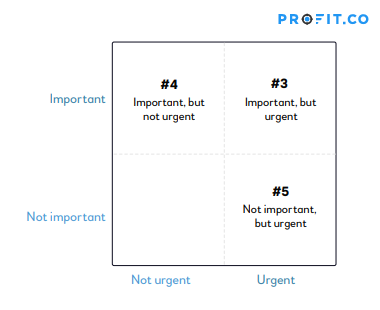
As you can see from the Action Prioritization Matrix above, your objectives can fall into 4 different quadrants:
- Not Important and Not Urgent.
- Not Important, but Urgent.
- Important, but Not Urgent.
- Important and Urgent.
After aligning and dependent objectives are taken care of, you should prioritize objectives that are in the Important & Urgent quadrant. While this might seem like a no-brainer, many companies tend to fulfill what is most urgent without thinking about the importance or impact of a goal.
The default method of prioritizing objectives might differ from industry-to industry. For example, for Manufacturing Companies, quality is a vital objective that will not always align with other goals within the company. According to the quality-first principle that many organizations practice — “Improve Quality” would be an essential objective, as well as an urgent one (as emphasized by the word “first” or “foremost” by many businesses.)
#4 – Important, but not Urgent Objectives
Next, prioritize important, but not urgent objectives. To understand what this type of OKR might look like, let’s look at an example scenario.
Let’s say you know that you have to get a solid outbound marketing program going. But you still need to perfect your inbound marketing before focusing on outbound, because of resource constraints. Such a goal would fall under the “Important, but Not Urgent” category, because while this goal isn’t necessarily under a time constraint, and may not seem as urgent as your outbound program, not fulfilling it will have negative impacts on your business down the line.
#5 – Urgent, but unimportant Objectives
Lastly, prioritize OKRs that are urgent, but unimportant. In every quarter with OKRs, there are always projects and targets that need to be taken care of right away.
For example, you might be a Sales leader, and it is important to prepare Sales Forecasts for an upcoming meeting. However, it is the end of the quarter, and your team needs your help in closing pending deals (which are both Important and Urgent). So, you will spend more time helping your team close deals. While the Sales forecasts do need to be completed, the OKR program asks you to consider the impact and outcomes of each project you prioritize or outcome you pursue.
Prioritizing Key Results within an Objective
Now that we’ve established how you should prioritize your OKRs in broad strokes, let’s take a look at specific key result prioritization.
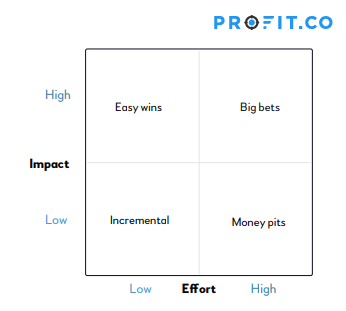
As you can see from the Action Prioritization Matrix above, your key results can fall in 4 categories as represented by the four quadrants:
- Incremental
- Money Pits
- Easy Wins
- Big Bets
#1. Incremental
This section is for low effort and low impact key results. For example, refreshing your webpages is a low effort, and might not have a considerable immediate impact, but the gains will compound over time.
#2. Money Pits
A key result that drains a lot of your energy or effort but only impacts your company marginally is called a Money Pit. For example, ‘Redesign ad campaigns’ may turn into a money pit when there is a resource shortage in your team. So, be aware of where key results could turn into money pits, and keep those outcomes on low priority.
#3. Easy Wins
An Easy Win is a key result that demands minimal effort but gives you a big bang for your buck.
For example, a key result of “Increase the number of page visits to 500” will result from a high-quality content strategy. The effort required is low, but the impact will be high.
Give these key results a higher priority.
#4. Big Bets
Key results that take much effort but are also highly impactful for your company are called Big Bets. For example, a key result such as “increase the number of leads to 500” is a big bet towards increased revenue generation.
So how do you balance the key results you have in a given quarter? To choose the right key results, follow these tips:
- Select as many “Quick Wins” as possible
- Select a couple of “Incrementals” per quarter
- Choose 1-2 “Big Bets” per quarter.
- Don’t take on any “Money Pits”
Teams should set three to five key results per objective. If you see an OKR that is an important objective followed by three money pit key results, you should step in and discuss the outcomes with your employees so that resources aren’t squandered on low impact items.
Success of your OKRs Depends on Goal Prioritization
The success of your OKRs relies heavily on your ability to Focus. To maximize focus, prioritization is essential. Knowing what and how to prioritize is the key to a successful OKR program.
If you want to manage your OKRs on an agile and intuitive framework that helps users maintain full transparency and alignment throughout the quarter, look no further than Profit.co. You can sign up for Profit.co completely free today!
How do you know if you have picked your Key results correctly?
Let us use an example and understand if the key results you have come up with are the right ones. In this example, the team is trying to reduce the page load time of a web page, to keep in line with Google’s recommendations for webmasters.
It is now well-known that “page load time” is one of the key factors for successful SEO. Apart from SEO considerations, page loading time is also a critical aspect from a UX standpoint.
Once this is decided as an important enough KPI to address, the engineering and the website teams work together and come back with five key results. Let’s take a look at this particular OKR, and see what is wrong with this; so we can fix it.
As you can see from the diagram, 4 out of the 5 KRs reflect the work they are trying to do:
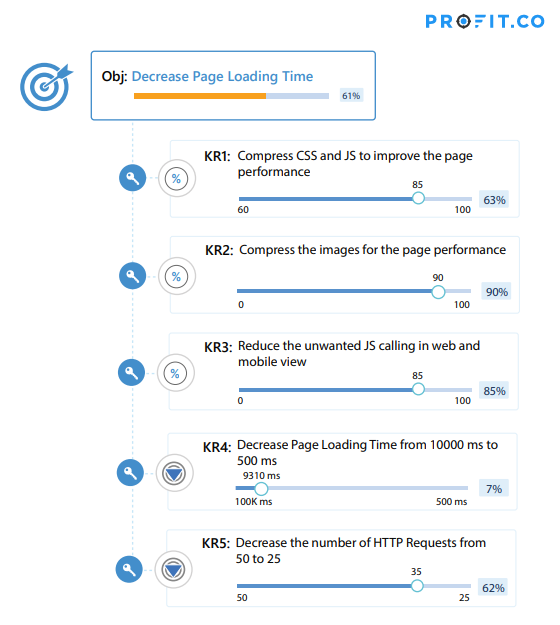
Let us say that both the Marketing and Engineering teams have approved this, and have started executing this Objective.
Three weeks into the cycle, you check in to see the progress of these key results. However, while you notice substantial progress has been made for key results 1, 2, 3, and 5, the fourth key result is sitting around 7%. As the topical key result, this presents a big problem.
The problem is that you are not achieving the bottom-line impact that you were planning to accomplish by executing the other four key results.
Something went wrong somewhere and detecting this anomaly three weeks into the quarter is a lot better than completing the entire quarter by realizing, “Hey, we did all of that, but then it didn’t make an impact.”
It’s important to detect errors like this one early so your team can course-correct and focus on what is most important. The OKR framework requires frequent check-ins, which help teams spot problems like this one.
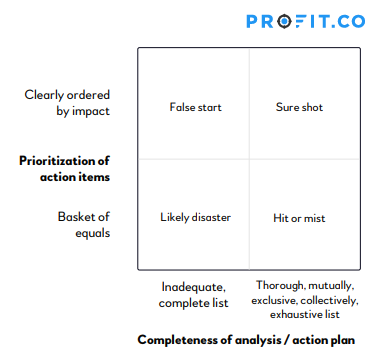
As you can see from this Two-by-Two Matrix, there are two axes here:
- Prioritization of Action Items on the Y-axis.
- Completeness of Analysis/Action Plan on the X-axis.
So, on each axis, there are two buckets. On the X-axis, completeness of action analysis/action plan, our range is from:
- Inadequate or incomplete list
- Mutually Exclusive and Collectively Exhaustive (MECE) list
On the Y-axis, prioritization of action items, our range goes from:
- Basket of Equals (the list of actions has not been prioritized properly)
to - Clearly Ordered by Impact
Now, if you start with an Inadequate or Incomplete list and do not prioritize and treat your actions as a basket of equals, you have a disaster waiting to happen. Unless you are fortunate, you are not going to achieve your Key Result. It is plain and simple. And our current situation is sort of like this.
Let’s say you have an Inadequate and Incomplete list, but then you try to order it by impact and begin. Even if you benefit from this progress, it is so clearly a false start.
Now, if you take a look at the bottom half of the matrix, even if your key results follow the MECE rule, it still won’t be a sure thing if you have not prioritized them properly. It will still be a hit or miss because depending on what you pick, you may not complete them if you cannot focus on what matters most.
Finally, there is the fourth quadrant. If you have a MECE’d list of key results, which is clearly ordered by impact, will give you a sure shot at achieving the objective you set out to fulfill.
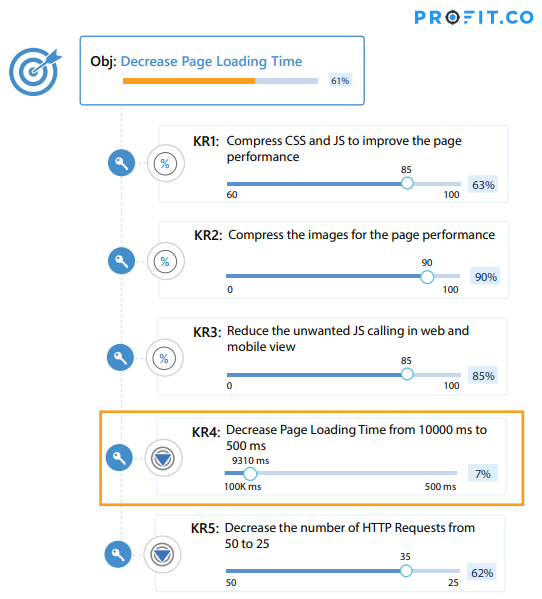
Let’s go back to the example OKR of “Decrease Page Loading Time”. This example suffers from an inadequate list problem because the team has made considerable progress on all four other items. But still, there is no impact on the KR and KPI that matters most.
This tells you that the key results make up an incomplete list. So, this means you must go back and look for other things that need to be done, which will give you an impact on the bottom line.
Prioritization does not seem to be a problem here, because the list is small, but it could be a problem in other situations. Once you have the full list, you will know if you have a prioritization problem. The first order of priority is to get the full list of key results, and then analyze your approach.
To learn more about how to prioritize goals and OKRs on an agile OKR management software, book a free demo with the Profit.co team today!

